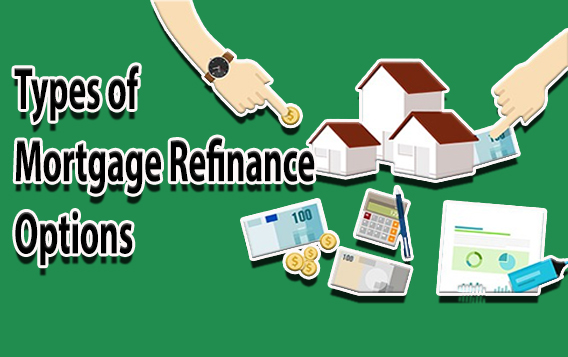It’s a big decision to refinance your mortgage and to decide the type of refinance to conduct. There are numerous types of mortgage refinance options available, including rate-and-term and cash-out refinance. The most common rate-and-term strategy involves acquiring a new loan with a different interest rate, loan term, or both, and replacing your current mortgage.

Moreover, several mortgage types allow for refinance options, which eliminate the need for an appraisal or thorough underwriting. However, your goals determine which refinance option is best for you. Furthermore, if you are seeking a reduced rate, a refinance or rate-and-term refinance may be a suitable option.
Types of Mortgage Refinance Options
There are various types of mortgage refinance options. Additionally, the kind of loan that a borrower chooses to take out is determined by their needs. Moreover, these types of mortgage refinance options include:
Rate-and-term refinance
Rate-and-term refinancing is the most common type of refinancing. The process is taking out a new mortgage with a different interest rate, loan duration, or both. A rate-and-term refinance is the best choice for a homeowner wishing to reduce their interest rate. One way to save money on interest and monthly payments is to refinance to a better rate. Furthermore, use a refinance calculator to see how rate reduction impacts payments, but note monthly payments may increase.
Streamline refinance
Homeowners with government-backed mortgages, such as FHA, VA, or USDA, may qualify for a streamlined refinance. Streamline refinances are designed to be faster and simpler due to reduced paperwork and the absence of property evaluation requirements. In addition, the two categories of streamlined refinance are credit-qualifying and non-credit-qualifying refinances.
A credit check is required for a credit-qualifying streamline refinance. In most cases, a credit check is not required for non-credit qualifying streamline refinancing. You will still have a loan with the same government program after this kind of refinance is finished, but the interest rate will change.
Cash-out refinancing
Cash-outs are frequent when the value of the underlying asset used to secure the loan has increased. The asset’s value or equity is withdrawn in exchange for a larger loan amount and often a higher interest rate. If an item’s paper value increases, it can be accessed through a loan instead of selling it. The borrower gains an increased loan amount while maintaining ownership of the item and immediate cash access.
Cash-in refinancing
A cash-in refinance involves the borrower contributing a substantial amount to the refinancing process instead of withdrawing it. You can lower your loan-to-value ratio (LTV) and raise your home’s equity by paying down a sizable chunk of your mortgage. However, this can result in lower interest rates or monthly payments. The best option for homeowners with underwater mortgages or those without substantial home equity is usually a cash-in refinance.
No-Closing-Cost Refinance
You might be able to refinance without having to make a sizable upfront payment if closing costs are a problem for you. This type of refinance allows for higher interest rates without additional fees or applying closing expenses to the principal balance. Furthermore, if you lack the funds to refinance your mortgage, a no-closing-cost refinance may be the most suitable option.
Conventional refinance
Conventional loans offer the highest borrowing requirements but usually the lowest rates. To qualify, you must have a debt-to-income ratio of 45% or less and a credit score of at least 620. Refinancing from an FHA loan to a conventional loan may potentially reduce the cost of FHA mortgage insurance.
Moreover, on a traditional rate-and-term or cash-out refinance, you might also be qualified for an appraisal waiver. This can expedite the loan application process and spares you the $300 to $500 that a house appraisal typically costs.
How to Choose a Mortgage Refinance Option
All mortgage refinance options have pros and cons, and depending on your goals, one strategy can work better for you than another. As you weigh your options, you should also take the following into account:
- Your current loan duration, interest rate, and mortgage payment.
- Your financial circumstances, such as your debt-to-income ratio (DTI) and LTV ratio.
- Your financial objectives and how refinancing fits into them.
- The amount of equity you own in your house.
Furthermore, determine the amount of closing fees and new monthly payments that you can afford to pay. Also, use a break-even calculator to find out how long it will take you to recoup your closing costs if you don’t intend to sell the house shortly.

